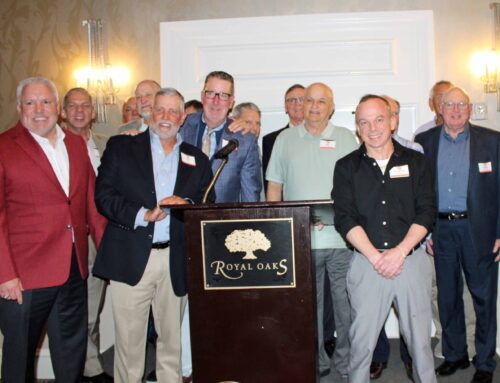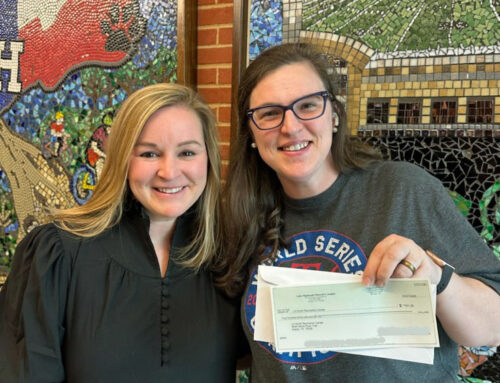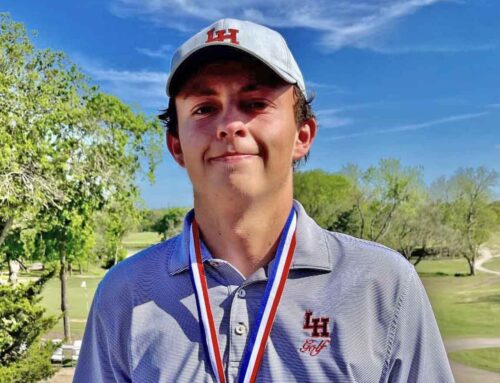It was the first day that Breck Mitchell’s chemistry classes had ever operated a Bunsen burner, and she wanted to make sure they understood the gravity of the situation.
“This is tricky business,” cautioned the Lake Highlands High School veteran. “My scars have gone away because it was a long time ago, but I know from experience that you can’t always see the Bunsen burner’s blue flame.”
After a detailed demonstration, and with strict instructions to wear goggles and aprons, Mitchell turned her 26 students loose.
Twenty-six students. Ten Bunsen burners. And only one pair of watchful eyes. Every high school science teacher is well aware of the dangers that can result from mixing these elements.
“And this is my small class,” Mitchell points out. “This afternoon, I have classes of 31 and 33.”
Fortunately, hers wasn’t the only pair of eyes scanning the room that day. She also had the help of Windy Winstead, a retired biology teacher and the school’s former science department chairman who was rehired this year as a part-time lab assistant. Without fail, each science teacher uses the same word to describe him: godsend.
“All of us think, how did we make it with just one of us?” Mitchell says. “Really, you don’t know what you’re missing.”
The position Winstead filled had been a need for years, says current department chair Ken Taylor, but there was never enough money in the high school’s budget to fund it – until last year when a group of parents and neighbors formed the Lake Highlands Academic Boosters.
The group’s proclaimed goal is to raise money for academic needs that are neglected each year as the state recaptures millions of dollars from Richardson ISD. Such campaigns have become a statewide trend as communities have found their school budgets coming up short. (Read the new column by neighbor Liz Luthans on page 59 for more information.) In its inaugural campaign, the Lake Highlands group raised more than $300,000 in cash and pledges, enough to pay for the $120,000 worth of wish-list items for this school year and have money leftover to start an endowment.
The part-time lab assistant position, which costs $23,000 annually, was high on the list when the boosters began their campaign last spring. The state requires 40 percent of science class time to be dedicated to laboratory work, and while that’s not impossible, says Taylor, it grows increasingly difficult for teachers to monitor these labs as classes enlarge.
It’s not just a safety issue, Taylor adds; it’s a learning issue, too, evidenced by the number of times students called out “Ms. Mitchell!” for help during the above experiment. Having Winstead in the room meant that students could get answers to their questions twice as fast. And Winstead also helps with logistics – setting up and tearing down labs, disposing of old chemicals and organizing new equipment, even repairing the occasional wobbly lab table or broken microscope.
“He’s enabled us to address things that normal staff or faculty just absolutely do not have the time to do, and I’m not talking about laying back and doing nothing or wanting to go home early,” Taylor insists. “I’m saying they just ain’t got the time to do it.”
Around the corner and down another hall, the boosters’ fundraising efforts are enriching another group of students – Mariana Mariel’s advanced-placement art history class.
“For many years that was probably one of the most desirable and viable AP classes here,” says principal Bob Iden. “Patty Rawlins taught it and took kids to Europe and Italy, and kids just clamored to get into that class each year.”
After Rawlins left, the class went through some changes, Iden says, and eventually ended up at the freshman center. But because of Mariel (and her $5,100 stipend supplied by the boosters), the school was able to bring the course back to campus.
The class is fairly small, with only seven students, because it wasn’t offered until after last spring’s enrollment period. But the few students who were able to work the class into their schedules hang on Mariel’s every word. She hails from Brazil, and most of her time is spent teaching Spanish. But for one hour each day, Mariel is able to impart the knowledge from her art history minor, and it’s obvious that she relishes this opportunity.
Taking the students on a journey through ancient Egyptian art, Mariel pauses on a slide of the death mask of King Tutankhamen.
“I still remember the first time I saw this picture,” she tells her class. “I was in fifth grade, and my dad had a National Geographic, and I would stare at it every day and go, ‘Wow, she’s so beautiful.’”
The students laugh along with Mariel at her childish blunder, then continue to pepper her with questions about features of the art. It’s beginning to sink in, Mariel says. One of her students recently came to class saying she had seen a mannequin at NorthPark Center in the Egyptian style – arms straight down, fists clenched, thumbs forward, totally rigid.
“She’s connecting it,” says Mariel, smiling.
They’re making other connections as well. When they studied the Grecian Parthenon, Mariel pointed out the statue of the goddess Athena holding the winged goddess Nike in her hand. Her class related the ancient winged goddess to the present-day athletic company, exclaiming: “So this is where Nike comes from.” Mariel simply assumed that her students were familiar with the statue, and they began laughing when they realized their teacher was thinking Greek, not tennis shoes.
But Mariel capitalized on the opportunity to make the distinction between art and pop culture.
“How can you think of a brand when this is who Nike is? Look at this beautiful picture. Look at this image,” Mariel told them. “This is what I think of.”
She’s pretty sure she got the message across.
“Now I know that every time they hear ‘Nike,’ they’re going to think of this statue,” Mariel says, then as an afterthought: “Well, I hope they do.”
Mariel’s and Winstead’s positions are just a small part of how the boosters’ funds are making an impact at the high school this year. The money is also paying for classroom sets of novels, journalism workshops, training for teachers who work with at-risk students, and much more. Faculty members say the help has been a huge morale booster, and has made Lake Highlands a pacesetter in Richardson ISD.
“We always knew this community was totally behind Lake Highlands High School in many ways,” Taylor says. “They’re interested in the academics of the children, and they’ve shown that with their contributions.”





